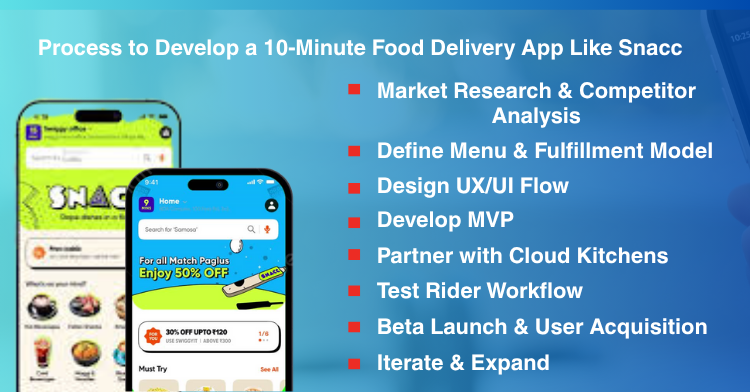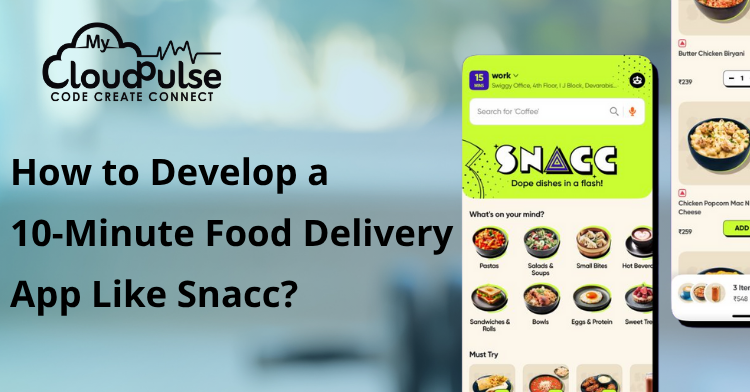The food delivery landscape is evolving at lightning speed. What once took 45 minutes to arrive at your doorstep now happens in just 10. This radical transformation is driven by consumer demand for instant gratification, a trend that’s reshaping how food businesses operate globally. To stay ahead in this shift, it’s time to develop a 10-minute food delivery app like Snacc—built for speed, simplicity, and scale.
In a hyperconnected and fast-paced urban environment, customers no longer want to wait for meals—they want snacks, beverages, and full-fledged meals delivered hot and fresh within minutes. This shift has paved the way to develop a food delivery app like Snacc by Swiggy, a game-changer in the Indian food-tech space.
Snacc launched as a standalone platform, targeting urban professionals, students, and Gen Z consumers who value speed, convenience, and variety. With micro-kitchens, a curated menu, and real-time logistics, Snacc redefines how we experience food delivery.
This blog is designed for startup founders, food-tech entrepreneurs, and app developers who want to explore and execute this revolutionary model. We’ll walk you through everything you need to build your own 10-minute food delivery app—from features and tech stack to logistics, monetization strategies, and estimated costs.
What is Snacc by Swiggy? – A Case Study Overview
Launched in early 2025, Snacc by Swiggy is India’s first 10-minute food delivery app that operates independently from Swiggy’s main app. This platform is built for speed and efficiency, offering quick, comforting food options that are ideal for busy lifestyles.
Snacc thrives on a carefully engineered business model that combines:
- Micro-fulfillment centers: Cloud kitchens placed in high-demand localities
- Limited menu SKUs: Designed for rapid preparation and consistent quality
- Exclusive in-house partnerships: Collaborations with D2C brands like The Whole Truth and Blue Tokai
Its core value proposition is the 10-minute delivery window, made possible through hyperlocal operations, strategically placed kitchens, and a streamlined menu. The app doesn’t just offer fast food—it provides a premium experience with a highly focused product line that includes Maggi, samosas, iced teas, health bars, and even full lunch bowls.
Snacc also features:
- A seamless, intuitive user interface
- Real-time GPS order tracking
- Secure and versatile payment options
- Exclusive new-user offers: ₹50 off and free delivery on first three orders
In short, Snacc combines Swiggy’s operational prowess with startup-like agility to create a highly scalable business model.
Market Opportunity for 10-Minute Food Delivery Apps
India’s quick-commerce market is booming, projected to surpass $5 billion by 2025, with 10-minute delivery services playing a significant role. Urban consumers are becoming more impulsive in their food choices, seeking instant meals that match their fast-moving routines.
Key Drivers of Demand:
- Changing lifestyles: Professionals and students working from home or offices want quick meals with minimal wait.
- High repeatability: A customer may order Maggi in the afternoon, coffee in the evening, and soup at night—all within the same day.
- Mobile-first behavior: Gen Z and millennials increasingly depend on apps for all their food and beverage needs.
Competitive Landscape:
- Zomato 15-min Tab: Experimenting with ultra-fast meals in select cities
- Zepto Café: Offers snacks, tea, and coffee alongside grocery delivery
- Blinkit Bistro: Quick meals in parallel with grocery baskets
These companies validate the rising demand for hyper-fast food. But with focused branding, Snacc carves a niche in snack-based, high-frequency orders—a model others are still adapting to.
Challenges to Watch:
- Fulfillment logistics: Maintaining 10-minute SLAs during rush hours or bad weather
- Menu constraints: Limiting variety while keeping customer interest alive
- Rider fleet stress: Ensuring delivery partners aren’t overburdened while maintaining speed
For new players, these challenges are real—but manageable with the right infrastructure and tech solutions.
Key Features to Develop a 10-Minute Food Delivery App Like Snacc
To make the 10-minute delivery promise work, your app needs to prioritize speed, simplicity, and synchronization between users, kitchens, and riders. Here’s a breakdown of must-have features for each stakeholder.
User App Features
- Instant Onboarding: Google or Apple sign-in for fast access
- Curated Menu Display: Category-based listings (snacks, drinks, bowls) with visual countdown timers
- Estimated Time of Arrival (ETA): Dynamically calculated ETA per item based on location and kitchen status
- Live Order Tracker: A map view with stages: Accepted → Cooking → Out for delivery → Delivered
- Wallet & Rewards System: Cashback, loyalty coins, and referral bonuses
- Smart Recommendations: Based on time of day or past behavior
- In-app Chat & Support: For issue resolution in real-time
Admin Dashboard Features
- Inventory Monitoring: Auto-update stock levels from kitchens in real-time
- Order Analytics: Real-time sales reports, average prep time, kitchen performance
- Geo-fencing: Manage delivery radius to ensure fulfillment within 10 minutes
- Role-based Access Control: Separate dashboards for kitchen staff, operations managers, and customer support
Delivery Partner App
- Smart Order Routing: Batch deliveries in dense zones using AI-based route optimization
- Rider Scoring System: Incentivize riders based on punctuality and customer feedback
- Traffic & Weather Alerts: To reroute or adjust estimated delivery windows
- Multi-language UI: For inclusivity across regions
A highly synchronized system across all interfaces ensures your brand keeps the 10-minute promise consistently.
Tech Stack Recommendation
The tech foundation of a 10-minute delivery app needs to be robust, scalable, and real-time. Your app’s infrastructure should support fast data retrieval, minimal latency, and high-volume concurrency.
Frontend Technologies
- Mobile App: Flutter (for rapid cross-platform development) or Swift/Kotlin for native performance
- Admin & Web Portals: React.js or Angular for clean and fast dashboards
Backend Technologies
- Server-side: Node.js (non-blocking operations), Django (if you prefer Python)
- Database: PostgreSQL (structured data), MongoDB (for product catalog), Redis (for caching live order data)
- Storage: Amazon S3 for image assets and menu media
DevOps & Hosting
- Cloud Providers: AWS or Google Cloud Platform
- Orchestration: Kubernetes + Docker for service isolation and scalability
- Monitoring Tools: Datadog, New Relic, Prometheus
- CI/CD: GitHub Actions, Jenkins for continuous updates
Essential APIs & Services
- Navigation: Google Maps / Mapbox
- Payments: Razorpay, Stripe, or Cashfree
- Notifications: Firebase Cloud Messaging
- Authentication: Firebase Auth, OAuth
- Analytics: Mixpanel, Segment, or Amplitude
Choosing a modular tech stack ensures your app remains agile and can scale easily when expanding to new cities or verticals.
Cloud Kitchen & Logistics Integration
A 10-minute delivery model is only possible when the distance between prep and drop is minimal. This is where cloud kitchens and hyperlocal logistics come in.
How It Works:
- You deploy micro-kitchens in high-density zones—business parks, student hubs, residential areas.
- Each kitchen operates within a 1.5–2 km radius, optimizing for prep and travel time.
- Items are designed for 5-minute prep time max, with partially prepped ingredients.
Fulfillment Workflow:
- Order is placed
- Kitchen gets an auto-alert with prep instructions
- Rider closest to kitchen is pinged in parallel
- Food is handed over within 2–3 minutes of cooking
- Rider takes the fastest route via AI pathing
Cloud kitchens are the logistical backbone. When linked seamlessly with inventory and rider apps, they ensure operational efficiency and customer satisfaction.
Monetization Strategies
While the low order value might seem like a limitation, the high frequency of orders more than makes up for it. Here’s how to monetize your 10-minute food app:
- Markup on Items: A small premium (5–10%) added to base prices
- Subscription Tiers: Similar to Swiggy One—offer perks like free delivery, faster support, and loyalty coins
- Delivery Fees: Use surge-based delivery fees during peak hours or bad weather
- Brand Collaborations: Let brands like The Whole Truth or local snack vendors feature exclusive products
- Sponsored Listings: Charge brands to be featured on the home screen or first scroll
This hybrid model balances affordability for users and sustainable margins for the platform.
Step-by-Step Process to Develop a 10-Minute Food Delivery App Like Snacc
Building a 10-minute delivery app involves much more than coding. Here’s a comprehensive approach:

- Market Research & Competitor Analysis – Study local demand, food preferences, and underserved zones.
- Define Menu & Fulfillment Model – Work with chefs to design a fast-cook, high-frequency menu.
- Design UX/UI Flow – Build wireframes with emphasis on speed: fewer taps to checkout.
- Develop MVP – Use agile development cycles; test with internal users first.
- Partner with Cloud Kitchens – Choose locations based on traffic and order heatmaps.
- Test Rider Workflow – Simulate delivery cycles to ensure 10-min feasibility.
- Beta Launch & User Acquisition – Offer deep discounts and cashback for first-time users.
- Iterate & Expand – Use analytics to refine menu, logistics, and pricing.
This phased strategy helps validate your business before full-scale expansion.
Estimated Development Cost
| Component | Estimated Cost (USD) |
| UI/UX Design | $5,000 – $8,000 |
| Mobile App (iOS + Android) | $15,000 – $25,000 |
| Backend & Admin Panel | $10,000 – $15,000 |
| Rider App | $5,000 – $7,000 |
| Cloud Kitchen Integration | $7,000 – $12,000 |
| Third-party APIs (Maps, SMS, etc) | $2,000 – $4,000 |
| Testing, QA & Deployment | $3,000 – $5,000 |
Total Estimate: $45,000 – $75,000 for MVP. Additional costs for marketing, scaling to new zones, and kitchen ops.
Key Takeaways and Success Tips
- Speed is Everything: Build every feature, flow, and process around fast fulfillment.
- Simplicity Wins: A tight menu ensures consistency and fast turnaround.
- Location is Key: Choose high-footfall areas for kitchen placement.
- Offer Transparency: No hidden fees. Show delivery timelines upfront.
- Build Community Loyalty: Use rewards and surprise treats to delight users.
Consistency and predictability will earn customer trust over time.
Conclusion
Snacc by Swiggy is more than a food app—it’s a blueprint for how modern consumers want to eat. The success of this model proves that customers are willing to trade variety for speed and reliability.
For entrepreneurs ready to ride this wave, the opportunity is massive. With thoughtful planning, smart logistics, and a streamlined tech stack, you can build a 10-minute food delivery app that not only competes but excels in today’s instant economy.
Build smart. Deliver fast. Satisfy more.
FAQs
By using cloud kitchens within a 1-2 km radius and preparing semi-cooked ingredients for instant final assembly.
It’s best suited for Tier 1 and Tier 2 cities with dense populations and a strong culture of food ordering.
Maintaining delivery speed during high traffic, weather issues, and staff shortages are the top risks.
Use order heatmaps from food delivery partners, analyze foot traffic data, and identify underserved zones.
For clarity and branding, a separate app is preferred, but technically it can be a tab or microservice within an existing platform like Swiggy or Zomato.



